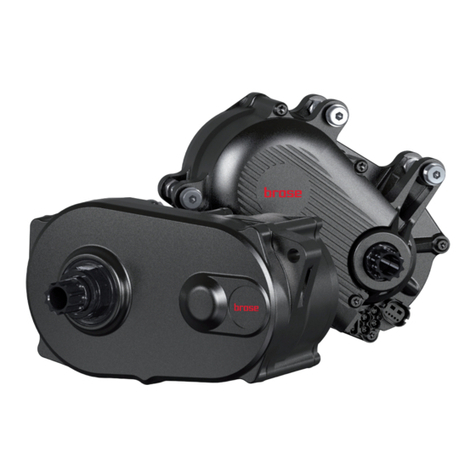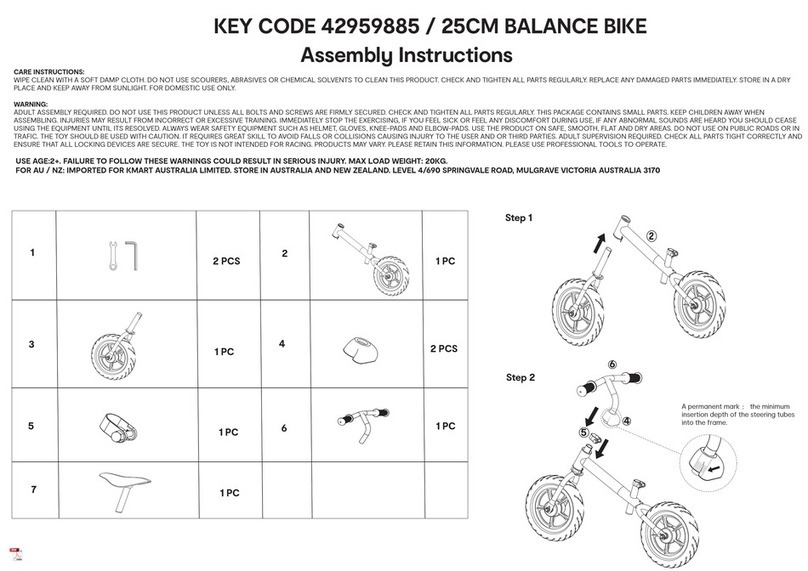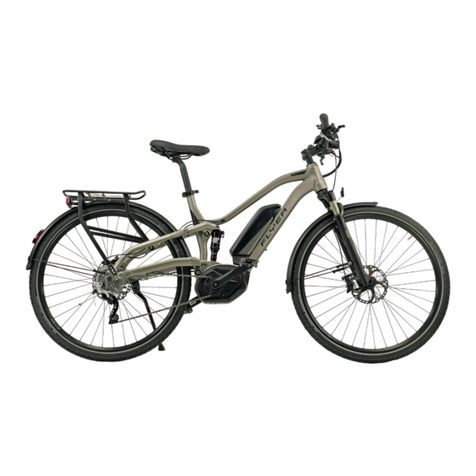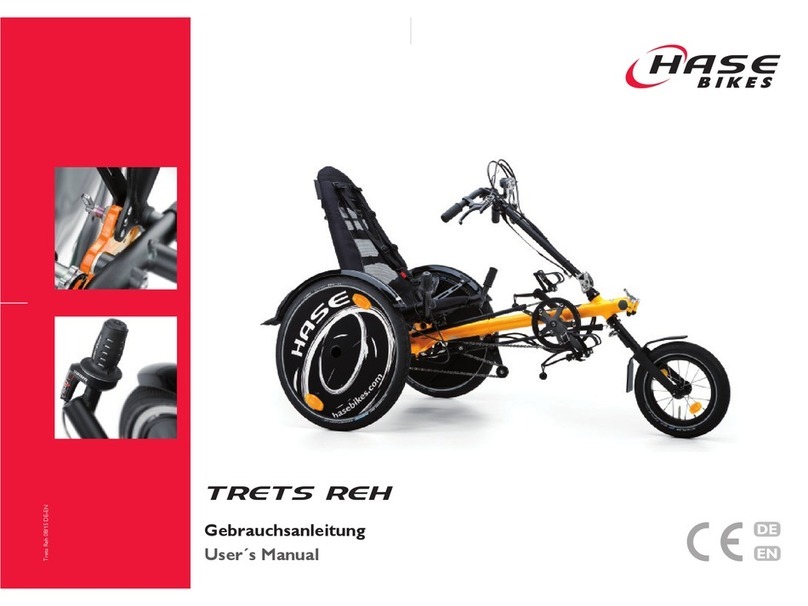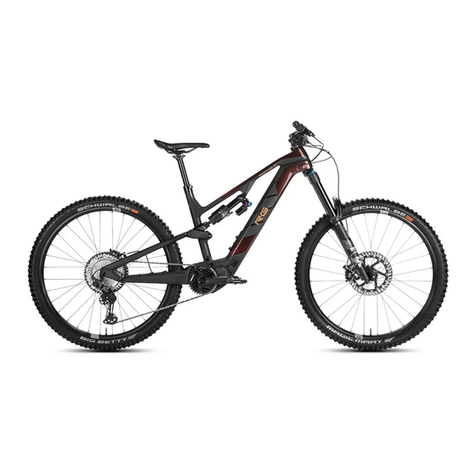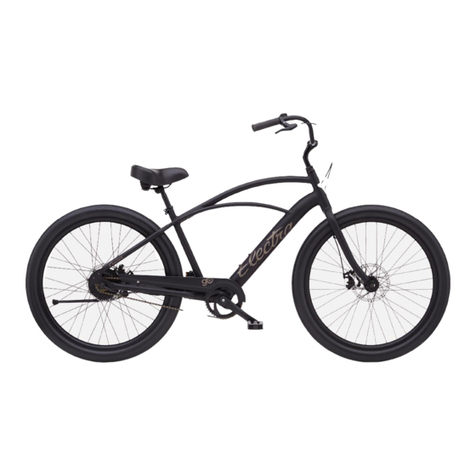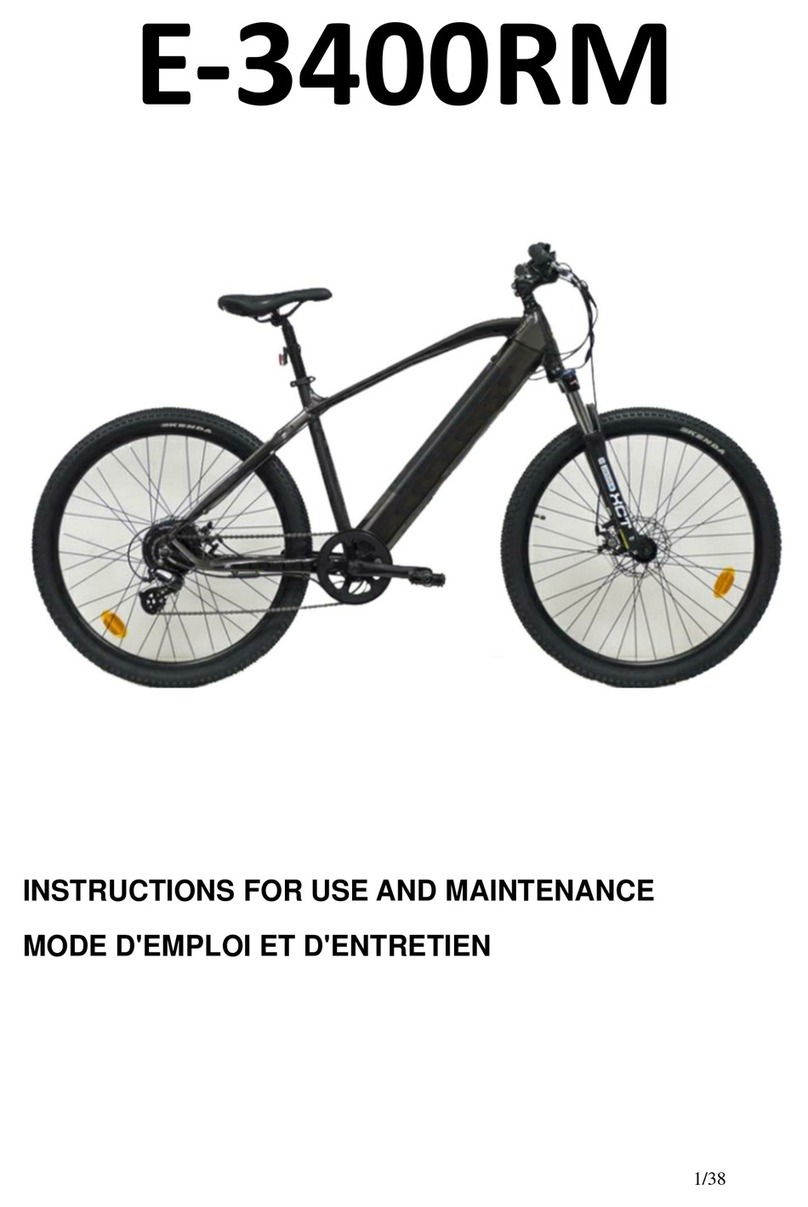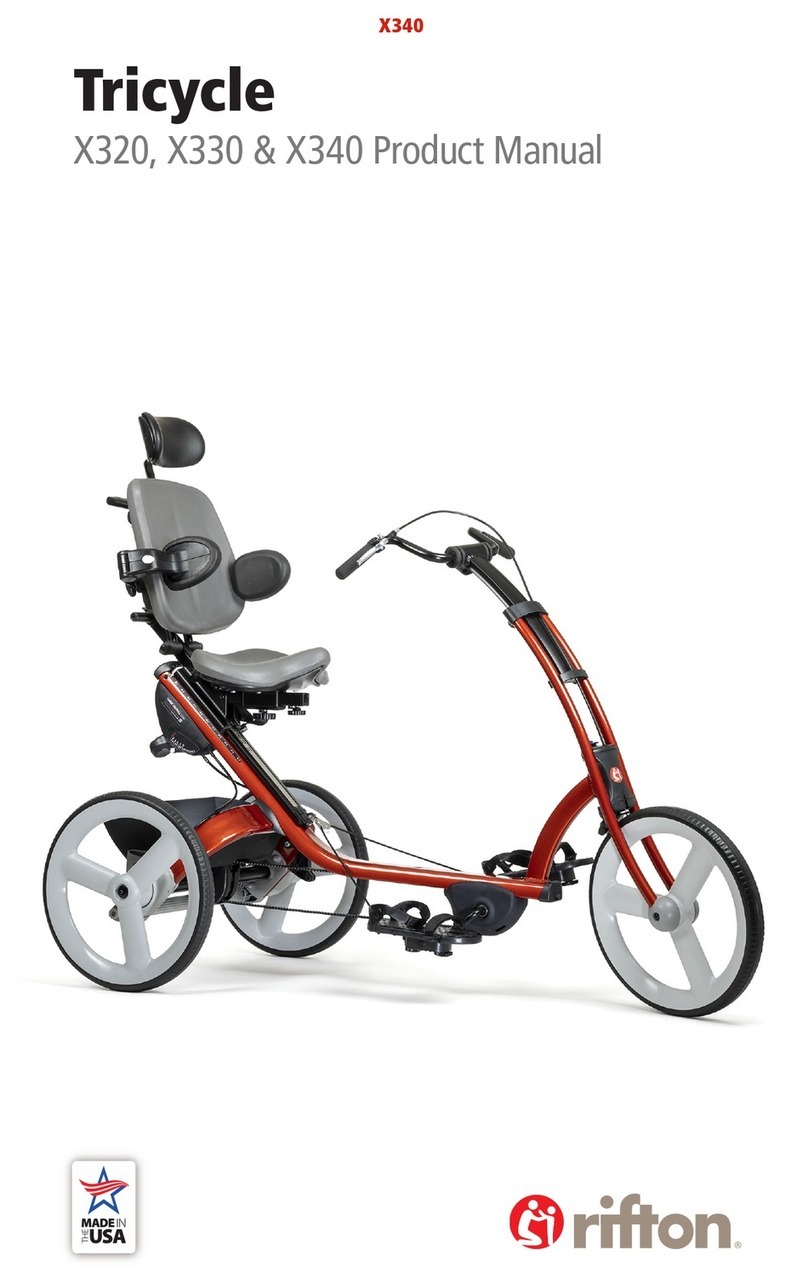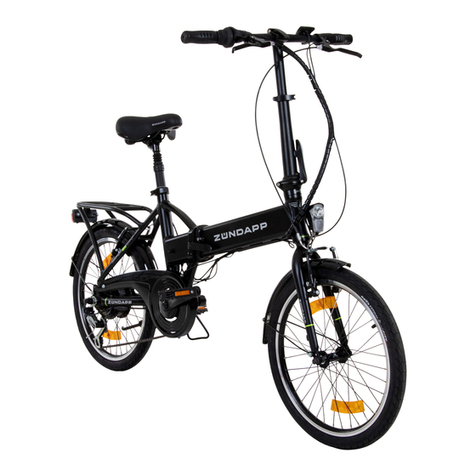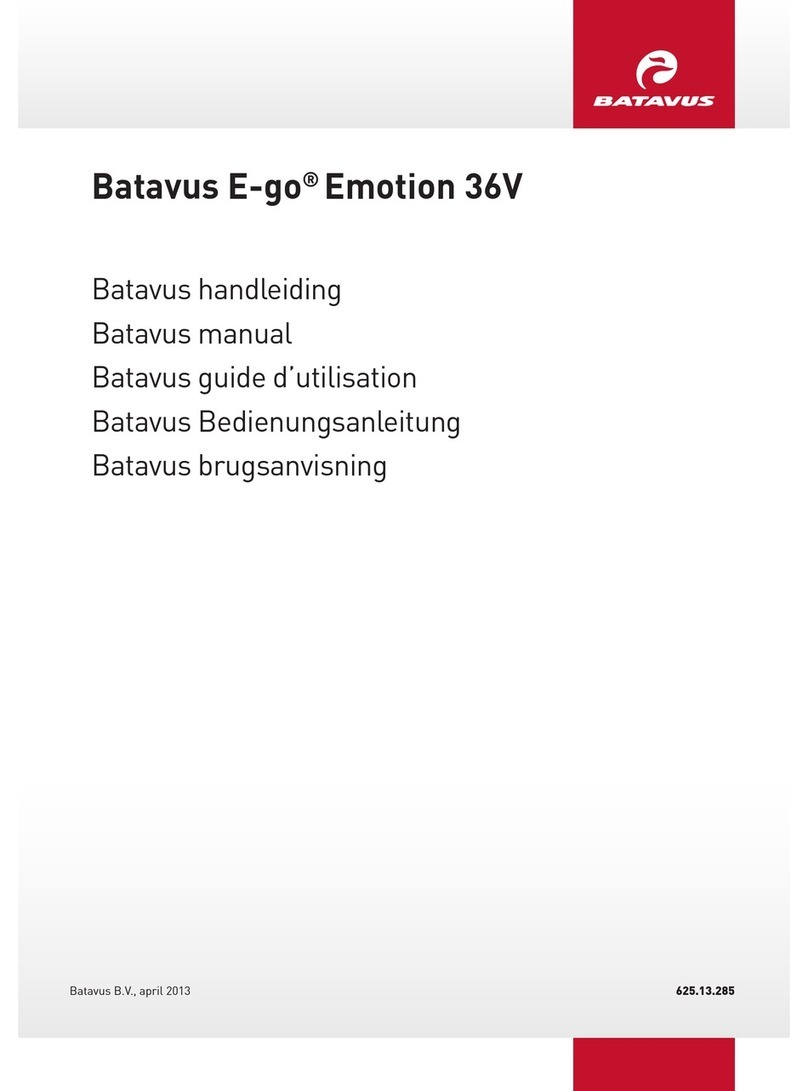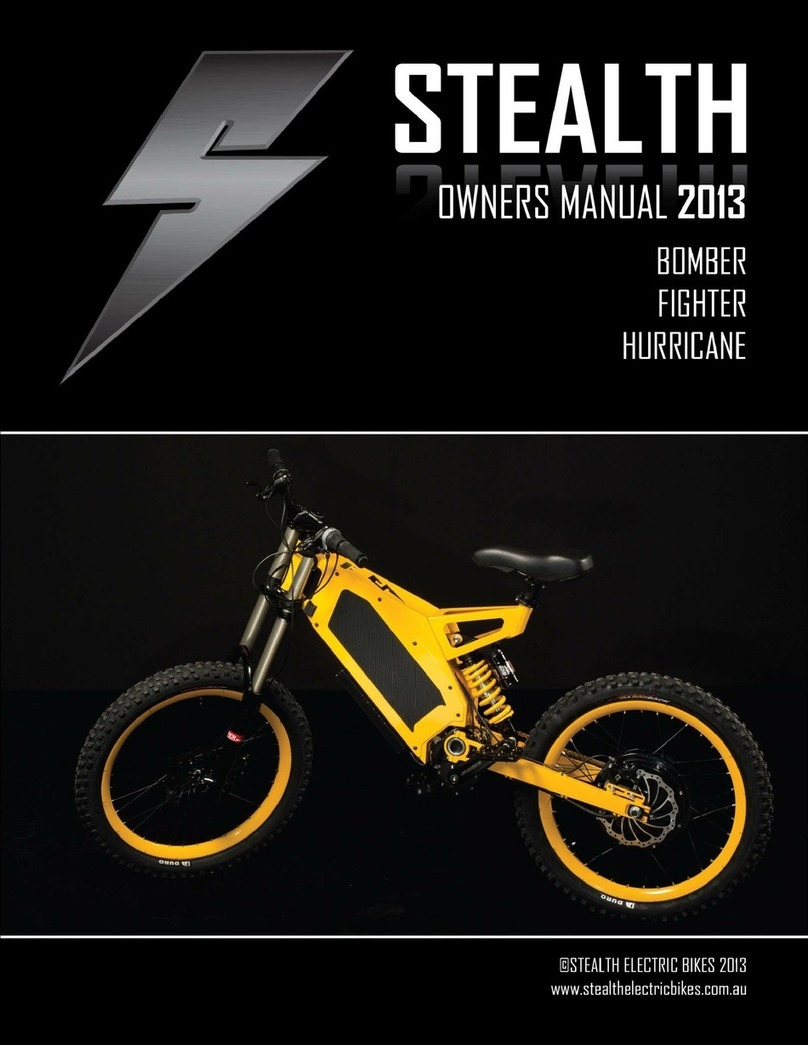WattWheels SCOUT User manual

WATTWHEELS LTD
1
SCOUT EBIKE MANUAL

WATTWHEELS LTD
2
CONTENTS:
INTRODUCTION PAGE 3
INSTALLATION PAGE 4
LCD DISPLAY PAGE 5-7
THROTTLE PAGE 7
BRAKES, TYRES, CHAIN PAGE 8
FOLDING PAGE 8-9
BIKING RANGE PAGE 9-10
RIDER SEAT HEIGHT & COMFORT PAGE 11
BATTERY & CHARGING PAGE 12
USEFUL TIPS PAGE 13
PARKING STORAGE & TRANSPORT PAGE 14
SAFETY CHECKS & BASIC TROUBLESHOOTING PAGE 15-16
ERROR CODES PAGE 17
SERVICING PAGE 18
WARRANTY INFORMATION PAGE 19-21

WATTWHEELS LTD
3
WELCOME
First off, welcome to the Wattwheels family! We are so happy to have you on board! You’ve picked a great model and, in this manual, we’re going to
break down the basics to make sure that your bike remains in top shape and performs to the highest standard.
You are about to experience the ride of your life. To get you out and having fun as quickly and as safely as possible please read the manual carefully,
paying close attention to the safety section.
Also, we highly recommend familiarizing yourself with local regulations for e-bikes and the components of the model that you have before your first
ride.
Please also ensure that the bike is regularly serviced as per the instructions later in this document. Failure to get the bike serviced can result warranty
claims being void if they are required. A bike is a vehicle and like a car needs to be serviced on regular occasions.
Wattwheels assumes that all persons involved in using, repairing, maintaining, cleaning, or disposing of this or any Wattwheels product must have
fully read and understood the content and meaning of these operating instructions.
Additionally, Wattwheels claims no responsibility for any injury or damage resulting in improper use of any electric bike.
USING THIS MANUAL
This manual contains details of the Scout bike, its equipment, and information on its operation and maintenance. Read it carefully and familiarize
yourself with the Scout before using it to ensure safe use and prevent accidents. This manual contains many Warnings and Cautions concerning the
safe operation and consequences if safe setup, operation, and maintenance are not performed. All information in this manual should be carefully
reviewed and if you have any questions, you should contact your local retailer immediately.
Because it is impossible to anticipate every situation or condition which can occur while riding, this manual makes no representations about the safe
use of bicycles under all conditions. There are risks associated with the use of any bicycle which cannot be predicted or avoided, and which are the
sole responsibility of the rider. You should save this manual, along with any other documents that were included with your bicycle, for future
reference, however all content in this manual is subject to change or withdrawal without notice. Visit www.wattwheels.co.nz to download the latest
version. Wattwheels makes every effort to ensure accuracy of its documentation and assumes no responsibility of liability if any errors or inaccuracies
appear within.

WATTWHEELS LTD
4
INSTALLATION IF REQUIRED:
(Refer to Video on our website for detailed instructions)
1. COMPLETLEY CHARGE THE BATTERY BEFORE THE FIRST USE
(Red light is on when battery is charging, green when fully charged. Approx. time is around 4-5 hours)
(PLEASE BE CAREFUL NOT TO PRESS THE BRAKES LEVERS WHILE THE FRONT WHEEL IS NOT INSERTED. DOING SO WILL RESULT IN THE BRAKES PADS
CLAMPING TOGETHER, AND YOU WILL NOT BE ABLE TO INSERT THE FRONT WHEEL WITHOUT BLEEDING THE BRAKES IN WHICH YOU WILL NEED A
BIKE WORKSHOP TO PERFORM)
2. ATTACH THE HANDLEBARS
3. ATTACH THE PEDALS
(Beware: The left-hand pedal has a reverse thread. To tighten, please turn anti-clockwise, right hand pedal is clockwise))
4. ATTACH THE SEAT POST
5. ATTACH THE FRONT MUDGUARD AND ATTACH FRONT LIGHT (if applicable)
6. INSERT THE FRONT WHEEL WITH QUICK RELEASE
7. CHECK ALL SCREWS AND BOLTS ARE TIGHT, SEAT POST THE CORRECT HEIGHT AND BRAKES WORKING PROPERLY

WATTWHEELS LTD
5
LCD DISPLAY FEATURES
The image shows the various features and information displayed on the LCD display. The display is controlled using the 3-button remote mounted on
the left side of the handlebar.

WATTWHEELS LTD
6
LIGHTS & BACKLIGHT DISPLAY
To activate the lights and illuminate the display hold down the + for 3 seconds, located on the keypad. A little icon should appear above the above the
PAS indicating the light is on. This will turn on the front and rear lights. To turn off, short press on/off button again. The bike also has brake lights
which will automatically turn on when the brakes are pressed.
TRIP/ODO
To toggle between the various modes press the “M” key quickly to switch between them.
BATTERY DISPLAY CAPCITY
The LCD readout on the handlebar of your Scout Bike features a battery capacity gauge (much like the fuel gauge on a car). It is recommended that
users stop operating the bike on electric once the bike starts flashing on the last bar and recharges. Remember you can still ride without using the
electric motor or display!
PAS (Pedal Assist Modes)
Pedal assist modes start from 1 and goes up to 7. PAS level 1 is the first pedal assist level and will give you some slight assistance. Press the up and
down arrows on the control panel to toggle between the levels. As you select the higher levels, the assistance will increase with level 7 basically doing
all the work for you. Using higher levels of PAS will drain the battery faster. The recommended level is PAS 1-3 to ensure good battery life. Note- PAS 0
means no assistance from the motor and you would have this on if you wanted to ride without assistance but measure km/speed etc. You can also
change the number of PAS modes. 0-3, 0-5, 0-7, 0-9. Please contact your local retailer with instructions on how to do this.
Please note the PAS is on a 5-minute timer. If the bike is stationary for a period of 5 minutes without any movement it will automatically turn off. This is a
safety feature employed on the bike
WALK MODE
To activate the walk mode, hold down the - key for three seconds. This will propel the bike forward at around 3km/r. This can be used if you need to
walk the bike up a hill and need some assistance in doing so.

WATTWHEELS LTD
7
TRIP RESET
To reset the trip count, hold down the + and –key for 3 seconds. It should then come up with a flashing TC with n. Press the up arrow to select y = yes
to reset
THROTTLE
The throttle is located on the left-hand side of the handlebars in the form of a thumb piece as pictured below. Please be careful as these throttles are
set to operate the Scout from stationary so any slight press of this will propel the Scout forward if the bike is in PAS 1 or above. The throttle can be
used when taking off from a stationary start, as a cruise control or just if you need a break! Please be aware using the throttle will drain the battery
much quicker than normal riding.
When using the throttle from a standing start please ensure you start in low PAS. Starting the bike in a high PAS and the highest gear can put a lot of stress on
the motor and will wear the motor faster.

WATTWHEELS LTD
8
BRAKES
The Scout electric bikes are equipped Tektro E350 hydraulic disk brakes. Please be aware the hydraulic disk brakes are very strong, so care is to be
taken braking initially, when getting familiar with the bike. The front wheel brake is located on right hand side with the rear wheel brake on the left.
For riders which prefers the brakes the other way around please get your nearest bike shop to switch over if required.
TYRE PRESSURE
To avoid flats, keep tyre pressure at the recommended PSI. On off-road terrain a slightly lower PSI will provide more grip, but flats can occur. We
recommend a pressure of between 5-35PSI. Scout tyres can be run at a very low PSI for greater traction over looser surfaces like sand, snow or mud.
FOLDING
To fold the bike three step are required. PLEASE MAKE SURE THE BIKE IS TURNED OFF BEFORE FOLDING AND WATCH YOUR FINGERS
1st –fold in the pedals. To do this hold the pedal and press inwards and then push down.
2nd - fold down the handlebars. Lift the little silver button and at the same time pull the latch down to release. The handlebars will then fold over.

WATTWHEELS LTD
9
3rd –Lift up the small black latch where the folding bracket is located on the main frame. Then pull towards you the main black latch to unlock. When
folding make sure the pedals are in roughly the same position as the photo
DRIVING RANGE
The range of your Scout is the distance the bike will travel on a single full charge of battery pack. The range values in this manual are estimates based
on expected usage characteristics. Some of the factors which effect range include changes in elevation, speed, payload, and acceleration, number of
starts and stops and ambient air temperatures. Tyre pressure and terrain are also important variables to consider.
We suggest that you ride conservatively when you first get your Scout Bike to get to know your bike and travel routes.
Once you become familiar with the range requirements of your travel routes, and the capabilities of your Scout Bike you can then adjust you riding
characteristics if you so desire.
The following table provides general estimates and outlines various factors effecting range and their combined estimated effects on range. This table
is meant to help owners understand the factors that can increase or decrease range, but Wattwheels makes no claims to the range that individual
users might obtain.

WATTWHEELS LTD
10
Expected
Range
Operating Conditions
30 Km
o Hilly Terrain
o Heavy Payload
o High Throttle use
o High Speeds
o High PAS
45 Km
o Flat Terrain
o Normal Payload
o Not Windy
o Medium Speeds
o Moderate PAS
60+ Km
o Flat Terrain
o Normal Payload
o Not Windy
o Low Pedal Assist Level
o Moderate to Heavy Pedalling
With the battery gauge located on the top left of the display please take note on new bikes the gauge can drop quite quickly initially. If this happens do not be
alarmed as this is normal and is due to the BMS (battery management system) we use in the bikes and it will take a few charges for the cells to balance out.
There will also be instances of voltage sag where the voltage drops when using a high level of PAS, biking up hills or under a heavy load which again is normal.
As mentioned, it is good to do a few smaller rides first to get familiar with the bike and the range you can get depending on what settings you have the bike on.
Pay close attention to the section in looking after your battery to prolong and maximise its life.
ADJUSTING THE SEAT HEIGHT
Use the quick release seat post clamp to release the seat post and pull upwards or push downwards to reach desired height.

WATTWHEELS LTD
11
Ensure seat post and seat are properly adjusted before riding. Do not raise the seat post beyond the MINIMUM INSERTION marking etched onto the seat post.
If your seat post projects from the frame beyond these markings, the seat post or frame may break, which could cause you to lose control and fall. Prior to first
use, be sure to tighten the seat clamp properly. A loose seat clamp or seat post binding bolt can cause damage to the bicycle or can cause you to lose control
or fall. Periodically check to make sure these the seat clamp is properly tightened.
RIDER COMFORT
To obtain maximum comfort, the rider should not overextend his or her arms when riding. To obtain the most comfortable riding position and offer
the best possible pedalling efficiency, the seat height should be set correctly in relation to the rider’s leg length. The correct saddle height should not
allow leg strain from over extension, and the hips should not rock from side to side when pedalling. While sitting on the bicycle with one pedal at its
lowest point, place the ball of your foot on that pedal. The correct saddle height will allow the knee to be slightly bent in this position.
BATTERY & CHARGING

WATTWHEELS LTD
12
The battery can be either charged by leaving the battery in the bike or by removing it. To charge while in the bike move the plastic cap located on the
battery and plug the charging 3 pin into the slot.
To remove the battery, remove the seat post or flip the seat up if you have one of the older models. Turn the key to the unlock position and then lift
the battery out. When turning to the unlock position you will need to press the key in to get to this position
Removing the battery from the bike when storing it for a long period of time is recommended. In this case store it in a cool, dry area away from water.
The charge left in the battery should be 50%-75% for long storage times.
Cleaning the battery and battery housing should only be done while disconnected and powered off. Use a dry rag or if needed a lightly damp rag.
DO NOT spray with high-pressured water to prevent damage or possible short-circuiting. Only charge the battery with the supplied charger as others may not
function properly, and this increases the possibility of fire or explosion.
Do not store the charger or battery in a wet/damp place or in direct sunlight.
Lithium-ion batteries can last longer if you recharge with 10-15% of the charge remaining to prevent damage to the cells. Keep both the battery and charger
out of the reach of children and If there appears to be an issue with the charger or battery, stop use immediately and contact either the manufacturer or
Wattwheels at admin@wattwheels.co.nz
BEST PRACTISES FOR EXTENDING BATTERY LIFE
o Use Pedal to assist when climbing hills and accelerating from a stop. Keep throttle to a minimum
o Avoid sudden starts and stops.
o Accelerate slowly.
o Keep within the recommended weight limit. (150kg)
CHARGING
•Firstly, insert plug of the charger into charging socket of the battery box.
•Second, Insert the charger into the socket of the home power supply. It shows the power has already been put through when the indicator lamp of
the charger is on.
•It is charging when the indicator light is red. When the light turns from red to green, it indicates that the battery is fully charged.

WATTWHEELS LTD
13
•After the green light is on, the charger is in little electric current and “fill slowly mode". It will not be harmful to the battery if left to charge for a longer
period or overnight. We do recommend not leaving for longer than 48hours if possible
DO NOT use the charger of other brands to charge. The charger contains a high-pressure circuit and is not compatible with some brands.
USEFUL TIPS
•When starting off or climbing hills, please try and ride with the pedal assist over the throttle, otherwise the energy consumption will be very high. By
doing this it can lengthen the life of battery and motor.
• This specified load of the Electric Bicycle is 150kg, please do not overload otherwise it will void the warranty
• While riding if the level of charge shows only one bar flashing is recommended to ride without power (in PAS 0) at this time and charge as soon as
you can.
• Turn off the display and remove the key, while parking or storing the bike.
• Inspect the bolts on a regular basis, to ensure that they are tight, and all components are secure. Pay close attention to crank bolts, cranks, stems,
quick release front and rear.
This is especially important if you are riding in demanding conditions.
• Regularly check the brake pads. The provided Tektro pads should be replaced if they have:
-Been contaminated.
-Have less than .8mm of material
-Cracks or deformation
• To replace the brake pads or perform other maintenance take it to a qualified bicycle mechanic at your local bike shop.
• Properly inflate your tyres according to riding conditions. Under-inflated tyres are prone to get flats, especially if riding off-road.

WATTWHEELS LTD
14
• Please don't dismantle and repair parts by yourself. Please go to your local bike repair shop. This bike comes with a manufacturer’s warranty
(document included) so any standard repairs please contact Wattwheels and we will arrange a service agent close to you to look at the bike. We carry
spare parts so anything electrical that a standard bike shop doesn’t have we will ship to your nearest retailer.
PARKING, STORAGE & TRANSPORT
Please follow these basic parking, storage, and transport tips to ensure your bike is well cared for on and off the road.
o When pushing the bike manually, turn off the power to avoid accidental acceleration from the motor.
o It is recommended to park indoors.
o Switch the power off, and any lights to conserve battery. Remove the key from the bike and ensure the battery is locked into the frame or removed
and brought with you for security if needed.
o In public places, your Scout Bike must be parked in accordance with local rules and regulations.
o If you must park outdoors in rain, or wet conditions you should only leave your Scout Bike outside for a few hours and proceed to park the bike in a
dry location afterwards to allow all the systems to dry out. Much like a regular bike, using in wet conditions mandates a more regular maintenance
schedule to ensure your bike does not become rusty, corroded and to ensure all systems are always working safely.
o Do not park, store, or transport your Scout Bike on a rack that is not designed for the size and weight of the bike.
o Wide tyres, as used on Scout Bikes, cannot fit into all bike racks, please select an appropriate rack for the width of tyres used on your bike.
o Locking up your bike is recommended to ensure your bike is secure and the chance of theft is reduced. Wattwheels makes no claims or
recommendations on the proper lock hardware or procedures to secure your bike, but we do recommend you take the appropriate precautions to
keep your Scout bike safe from theft.
o When storing your bike or carrying your bike on a rack for transport, you can remove the battery pack to reduce the weight of the bike and make
lifting and loading easier.

WATTWHEELS LTD
15
2. Wheels and Tyres
o Ensure tyres are inflated to within the recommended limits displayed on the tyre sidewalls.
o Ensure tyres have tread and have no BULGES OR EXCESSIVE WEAR.
o Ensure rims run true and have no obvious wobbles or kinks.
o Ensure all wheel spokes are tight and not broken.
o Check axle nuts and quick releases to ensure they are tight. If your bicycle is outfitted with quick release
axles, ensure the locking levers are correctly tensioned and in the closed position.
3. Steering
o Ensure the handlebar and stem are correctly adjusted and tightened and allow proper steering.
o Ensure the handlebars are set correctly in relation to the forks and the direction of travel.
4. Chain
o Ensure the chain is oiled, clean and runs smoothly.
o Extra care is required in wet or dusty conditions
5. Bearings
o Ensure all bearings are lubricated, run freely and display no excess movement, grinding or rattling.
o Check headset, wheel bearings, pedal bearings and bottom bracket bearings.
6. Cranks and Pedals
o Ensure pedals are securely tightened to the cranks.
o Ensure the cranks are securely tightened and are not bent.
7. Derailleurs
o Check that the derailleur(s) are adjusted and functioning properly.
o Ensure shift and brake levers are attached to the handlebar securely.
o Ensure all brake and shift cables are properly lubricated.
8. Frame and Fork
o Check that the frame and fork are not bent or broken.
o If either are bent or broken, they should be replaced.
9. Accessories
o Ensure all reflectors are properly fitted and not obscured.
o Ensure all other fitting on the bike are properly secured and functioning.
o Ensure rider is wearing a helmet and any other required riding safety gear.
10. Motor Drive Assembly and Throttle
o Ensure mid-motor is spinning smoothly and the motor bearings are in good working order.
11. Battery Pack
o Ensure battery is charged before use.
o Ensure there is no damage to battery pack.
o Lock battery to frame and check to see that it is secured.
BASIC TROUBLESHOOTING
SAFETY CHECK
BASIC STEPS
1. Brakes
o Ensure front and rear brakes work properly.
o Ensure brake pads are not over worn and are correctly positioned in relation to the disc rotors.
o Ensure brake control cables are lubricated, correctly adjusted, and display no obvious wear.

WATTWHEELS LTD
16
Symptoms
Possible Causes
Most Common Solutions
It doesn’t work
1. Insufficient battery power
2. Faulty Connections
3. Battery not fully seated in tray
4. Improper turn on sequence
5. Brakes are applied
1. Charge the battery pack
2. Clean and repair connections
3. Install battery correctly
4. Turn on bike with proper sequence
5. Disengage brakes
Incorrect distance, speed readings
and/or
reduced top speed
1. Insufficient battery power
2. Speed sensor is not centred or missing
1. Charge or replace battery
2. Check on the rear wheel that the silver disk matches up in the centre
of the black sensor.
When powered on the motor does
not respond
1. Loose wiring
2. Loose or damaged throttle
3. Loose or damaged motor plug wire
4. Damaged motor
1. Repair and or reconnect
2. Tighten or replace
3. Secure or replace
4. Repair or replace
Reduced range
1. Low tyre pressure
2. Low or faulty battery
3. Driving with too many hills, headwind,
braking and/or excessive load
4. Batter discharged for long period of time
without regular charges, aged or damaged.
1. Adjust tyre pressure
2. Check connections or charge battery
3. Assist more with pedals or adjust route
4. Replace the battery
The battery won’t charge
1. Charger not connected properly
2. Charger damaged
3. Battery damaged
4. Wiring damaged
1. Adjust the connections
2. Replace
3. Replace
4. Repair or replace
Wheel or motor makes strange
noises
1. Damaged motor bearings
2. Damaged wheel spokes or rim
3. Damaged motor wiring
1. Replace
2. Repair or replace
3. Repair or replace motor.

WATTWHEELS LTD
17
ERROR DECTECTION
Your Scout Bike is equipped with an error detection system integrated into the LCD display and motor controller. In the case of an electronic control
system fault an error code should display. The error codes are listed below and can help detect what the issue is on the bike. If your bike has an error
code displayed at any time it is recommended that you cease operation and contact your local dealer or Wattwheels.
21 CURRENT ISSUE
22 THROTTLE ERROR
23 MOTOR ISSUE
24 HALL SENSOR ISSUE
25 BRAKE LEVER ISSUE
MOST COMMON ERROR –USUALLY CAUSED BY PRESSING THE BRAKES WHEN TURNING ON. IF THIS PROBLEM CONTINUES YOU CAN DISCCONNECT THE BRAKE CUTOFFS FOR A
TEMPORARY FIX. THESE ARE A PLUG WHICH PULLS APART AND IS LOCATED 10CM FROM BRAKE LEVER. RED INSIDE WHEN DISCONNECTED.
30 COMMUNICATION ERROR

WATTWHEELS LTD
18
SERVICING
To ensure your bike remains in great shape just like a car it requires regular servicing. Failure to do so may void any potential warranty claims. Please
retain your receipts for proof of service
2-3 MONTHS: 12 MONTHS:
DATE: DATE:
STORE/MECHANIC: STORE/MECHANIC:
SIGNATURE: SIGNATURE:
6 MONTHS: 24 MONTHS:
DATE: DATE:
STORE/MECHANIC: STORE/MECHANIC:
SIGNATURE: SIGNATURE:

WATTWHEELS LTD
19
WARRANTY
To activate your warranty please go to https://www.wattwheels.co.nz/warranty. A link is located at the bottom of
our webpage.
Wattwheels Ltd warrants that all new products are warranted to the Buyer against manufacturing defects in materials and/or workmanship for the following periods:
Motor/Battery 24 months
Frame 60 months (Folding bikes & trikes is 36months)
Additional Components 12 months
For commercial operations where the bikes are being used a hire bike then the following applies:
Motor/Battery 12 months
Frame 24 months (Folding bikes is 18months)
Additional Components 6 months
The warranty period is calculated from the point of delivery. The original receipt of purchase is required to establish proof of purchase and must be provided to
Wattwheels for all warranty claims. Wattwheels will require the customer to complete a MANDATORY standard procedure for warranty claims that will involve media
such as photos and videos to help Wattwheels after sales staff establish the fault with the product.
Goods we sell are subject to a full comprehensive warranty. The costs/inconvenience caused by the loss of use of the product, is not covered whilst the warranty
procedure takes place. The warranty for replacement components will be based on the date of delivery. Under no circumstance will a replacement component have
a warranty date different than the original date of delivery. If a replacement is necessary due to a defect in materials and/or workmanship, then upon return to
Wattwheels, the component will be replaced during the warranty period.
Wattwheels will have no obligation under this warranty in the event the product is damaged or destroyed as a result of any of the following events: components
used on a non Wattwheels product, damage or destruction by abuse; collision; theft; improper maintenance or mishandling of the product; natural forces such as

WATTWHEELS LTD
20
wind, lightning, hail, etc.; any wilful or negligent act; penetration, or opening of the product casings in any manner. Replacement will be honoured only by
Wattwheels.
This is Wattwheels exclusive warranty. No party is granted express or implied authority to change or annul this warranty in any manner. Implied warranty including
that of merchantability and fitness for a particular purpose are expressly limited in duration to the duration of this warranty. Wattwheels disclaims any liability for
special, incidental or consequential damages.
This warranty is not meant to suggest or imply that the products cannot be broken or will last forever. It does mean that the product is covered subject to the terms
of the warranty. This warranty applies only to the original Buyer of the product and is not transferable to subsequent owners or any other party. This warranty is void
if the product is subjected to abuse, neglect, improper repair, improper maintenance, alteration, modification, an accident or other abnormal, excessive, or improper
use, at the sole discretion of Wattwheels.
Warranty Exclusions
This warranty does not cover:
• normal wear and tear
• damage or failure from abuse, neglect, misuse, or accident
• damage from stunt riding, ramp jumping, acrobatics, competitive events, such as bicycle racing, bicycle motocross racing, or similar activities or any activity that is
not consistent with the intended use of the product
• damages resulting from improper charging of the battery pack or use of any charger not supplied by Wattwheels
• installation of any parts, accessories, or electrical component(s) not originally intended for or compatible with the product as sold, or any modification of the frame
or any component(s) originally supplied; tires, brake pads, chains, lights, motors, battery packs, displays, or vehicle controllers that have been opened for any
purpose whatsoever, other than by Wattwheels
• All warranties are void if the product is used for any purpose other than the reasonable intended use of the product. Additionally, this warranty does not cover
damage associated with commercial use.
• Aftermarket components or modifications
All implied warranties, including the warranties of merchantability and fitness for a particular purpose, are limited in duration to that of the express warranties stated
above.
Warranty Procedure
Proof of purchase must be provided. The original Purchaser must contact a Wattwheels representative to discuss the problem with the product. The original
Purchaser is responsible for the return of the product, undamaged in transit, to Wattwheels for warranty work and for the costs associated with shipping the
component(s) when returning them. If Wattwheels determines a warranty claim is valid and conforms with this warranty, Wattwheels will replace component(s). For
valid warranty claims hereunder, Wattwheels will reimburse the original Purchaser for shipping costs incurred as a result of returning the product to Wattwheels for
warranty work at standard ground shipping rates, and Wattwheels will pay for shipping costs to return the product to the original. You must retain and send us the
receipts for shipping.
Table of contents
Other WattWheels Bicycle manuals

